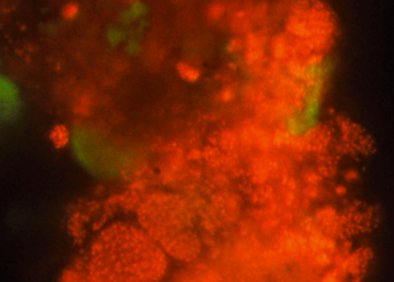Nitrification
A plant's nitrification is crucial for the removal of nitrogen and consequently, for the compliance with limit values. Imbalances of the nitrification process are therfore particularly problematic.
The bacteria responsible
Conversion of nitrogenous compounds to nitrate is a process essential for minimizing the concentration of nitrogenous compounds in the receiving waters. The group of nitrifying bacteria are responsible for this conversion and are divided into ammonia-oxidizing bacteria and nitrite-oxidizing bacteria.
Nitrifying bacteria
Nitrifying bacteria are comprised of the groups of ammonia-oxidizing bacteria (AOB) and nitrite-oxidizing bacteria (NOB). They belong to the group of chemolithotrophic bacteria and can, if present, either oxidize ammonia to nitrite or oxidize nitrite to nitrate.
Ammonia-oxidizing bacteria
Ammonia-oxidizing bacteria oxidize ammonia to nitrite. Typically, they are closely associated with nitrite oxidizing bacteria.
Nitrite-oxidizing bacteria
Nitrite-oxidizing bacteria oxidize nitrite to nitrate. They have differing tolerance limits for nitrite, i.e. at a certain nitrite level, they are inhibited. Oxidation of nitrite produces nitrate, which is subsequently reduced to nitrogen by denitrifying bacteria.
Observe changes in nitrifying bacteria, act timely
Detection of nitrifying bacteria directly in the process enables to notice population shifts, before effluent limit values are exceeded. Consequently, process changes can be introduced in a timely manner.
Detecting nitrifying bacteria with VIT®
With VIT® gene probe technology, nitrifying bacteria can be detected directly in the wastewater sample. AOB and NOB are reported individually. Visualization enables an additional evaluation of their activity.
Test kits for the direct on-site analysis:
Analysis of the sample in vermicon AG's laboratories:
Anammox analysis
Nitrifying bacteria analysis
Nitrifying bacteria detailed analysis
Denitrifying bacteria analysis

AOBs shine red. NOBs shine weakly green - only present in small numbers and hardly active.

AOBs shine red, NOBs shine green. Both populations are active and in good balance.
Workshops
Our practical workshop "Prevention of Disturbances in the Biological Wastewater Treatment" provides a well-balanced mix of theory and practice, including insight into your own samples, as well as know-how according to the lastest scientific findings.
Information and RegistrationPublications
Get an overview of the publications dealing with the application of our technology in wastewater and request further information.
To the publicationsNewsletter
Register for our newletter without any obligation and get regular updates on new products, our company and special promotions.
RegistrationPrevention of Disturbances
Discover how the monitoring of (micro)biological processes can be successfully integrated into a plant’s process analytics.
Learn more